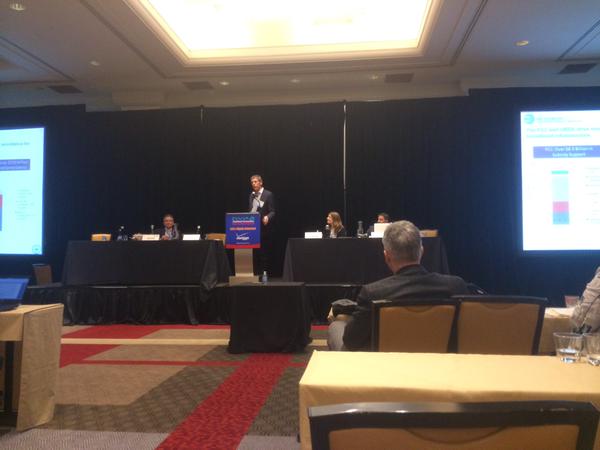Jonathan Chambers of the FCC Says Results of Rural Broadband Experiment Teach Incumbents a Lesson
AUSTIN, April 14, 2015 – The official from the Federal Communications Commission responsible for the agency’s unique “rural broadband experiment” on Monday said the experiment was less about learning than about teaching the rural telecom industry that it can do better. Speaking on panel at the Broa
AUSTIN, April 14, 2015 – The official from the Federal Communications Commission responsible for the agency’s unique “rural broadband experiment” on Monday said the experiment was less about learning than about teaching the rural telecom industry that it can do better.
Speaking on panel at the Broadband Communities Summit here, Jonathan Chambers, chief of the Office of Strategic Planning at the FCC, said: “I wanted to teach certain people in Washington that we could do better than 4 megabits per second (Mbps) down and 1 Mbps up [in broadband speeds.]”
“I wanted to teach that there was an interest in deployment of broadband to [rural residents’] homes, and in their home communities,” Chambers continued.
Less that $100 million over a 10 year period is being made available through this rural broadband experiment. That $10 million a year, Chambers said, is two-tenth of one percent of the amount — $4.5 billion — that is annually made available to traditional rural telecom companies.
Chambers said he wanted to teach Washington that changes to the entrenched system of universal service could be done, and that significantly better broadband could be made widely available throughout rural America “because there are models that work differently in different places.”
In essence, Chambers said, the innovation of the rural broadband experiment was to explore the question: “What would happen if we made [funds] available to [entities] other than phone companies in rural America?”
In Chamber’s view, the response was impressive.
In an FCC blog post last December, Chambers wrote:
We received bids from telephone and electric co-ops, from mobile operators, from wireless internet service providers, from cable companies, from communities, and from a satellite provider. We received bids from start-ups and from companies that have been around for over 100 years. We received bids to provide broadband via copper, fiber, licensed and unlicensed spectrum. We received bids from national operators, but mostly the bids came from companies that were locally based, with more than an occasional effort to try new strategies to get broadband to unserved communities.
We received 575 bids from 181 different entities to cover homes and small businesses in over 75,000 census blocks in rural areas in every state in the country. The total amount requested far exceeded the budget, nearly nine times as much as was available to fund in the auction. And it appears that the auction succeeded in drawing bidders who believe they can provide service very economically. For example, when we compared the bids to the amount of support calculated by the FCC’s cost model, the total requested in the auction in the aggregate is less than half the model-based support for those census blocks. And the total from the group of lowest bidders is just ten percent of the model-based support for those particular blocks.
This incredible outpouring of interest was attributable to communities’ greater buy-in when they were able to have a stake — separate and apart from a rural telecom company — in their broadband future.
“There are places where a community will put stuff up, and we didn’t have to follow the model we have followed for years,” Chambers said.
He also noted with pleasure that the FCC had upped its definition of broadband to 25 Mbps, which he called “the basis for the rural broadband” experiment.
In noting that the bids obtained under the rural experiment were half as much as the agency pays for traditional “high-cost” universal service support, Chambers said Monday that most of the proposals were “fiber to the home, which would deliver far greater speeds, less latency, and more reliable service than the FCC has sought in past years.”
The panel on which Chambers spoke, “Federal Loans, Grants and Universal Service Fund Support,” was a last minute addition to the program. Also on the program was Sandeep Taxali, senior policy analyst at the Commerce Department’s National Telecommunications and Information Administration, and Laurel Leverrier, operations branch chief policy for the Agriculture Department’s Rural Utilities Service.
Both Taxali and Leverrier spoke about their agency’s broadband programs, including the Broadband Advisory Council of federal government entities recently announced by President Obama.
Drew Clark is the Chairman of the Broadband Breakfast Club. He tracks the development of Gigabit Networks, broadband usage, the universal service fund and wireless policy @BroadbandCensus. He is also Of Counsel with the firm of Kirton McConkie, based in Salt Lake City, Utah, which enhances clients’ ability to construct and operate high-speed broadband networks in public-private partnerships. You can find him on LinkedIN, Google+ and Twitter. The articles and posts on BroadbandBreakfast.com and affiliated social media are not legal advice or legal services, do not constitute the creation of an attorney-client privilege, and represent the views of their respective authors. Clark brings experts and practitioners together to advance the benefits provided by broadband: job creation, telemedicine, online learning, public safety, energy, transportation and eGovernment.










Member discussion